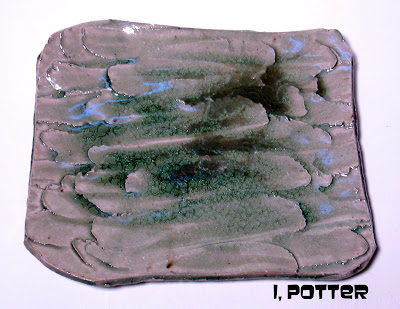What is silver on the outside and gold on the inside, well based on the chawan illustration the answer could in fact be a Banura Shiro chawan. Perhaps it has something to do with growing up with a lacquer artist for a father but this kuro-chawan has silver and gold applied in a manner that is vaguely reminiscent of rubbed negoro or even kanshitsu style lacquer though modified and adapted stylishly to his work. Banura who worked in Iga is well known for his graphic painted pottery which as you think about it many of these pieces seem to spring from lacquer designs applied to simple yet evocative three dimensional forms. This particular chawan reminds me of an Edo period creation going beyond the ordinary chadogu expectations and combining a rugged and purposeful form and glaze with just the right degree of luxury and aristocratic nobility. As you can see in this short video slideshow the silver and gold are not overly bright or thickly applied striking a balance between too much and just the right amount and as you reflect on the work of Banura Shiro you will recognize that he had made a career out of doing just that. Enjoy the slideshow.
Wednesday, December 30, 2020
Monday, December 28, 2020
LEFT OVERS
Friday, December 25, 2020
SEASON'S GREETINGS!
Wednesday, December 23, 2020
GHOST OF CHRISTMAS PAST
Monday, December 21, 2020
ECB TS8
Friday, December 18, 2020
ONI-SHINO REVEAL
Wednesday, December 16, 2020
AKA-CHAWAN
Monday, December 14, 2020
SPILLWAYS
Friday, December 11, 2020
HAGOROMO GUINOMI
I have had this short video slideshow on the hard drive for some time and thought it was as good a day as any to put it up on Youtube and my blog. This yuteki style, partridge feather guinomi was made by veteran iron glaze specialist Kimura Morikazu and shows off just one of the myriad of styles and surfaces that he mastered along his long career which started out in Kyoto before he moved off to Echizen. This nice yuteki-temmoku guinomi has a nice array of features and effects that creates a rich tapestry to enjoy and bringing to mind the hagoromo, the feathered cloak. I hope this slideshow as short as it is helps fill in the blanks of the form, surface and subtleties of this guinomi by Kimura Morikazu and is the next best thing to having in hand.
Wednesday, December 9, 2020
TRANSPACIFIC VOYAGE
Given the current state of affairs and the dramatic increase in getting pots from Japan to the US I had decided early on to try my hand at getting a pot or pots shipped by surface, seamail, a practice I have been using for printed materials for quite some time. Illustrated is the very first attempt at doing so which arrived after what seemed like an eternity but in absolutely great shape from pot, wood box and even the other cardboard box. Granted this was packed rather well but I gave the odds for at about 25% which was oddly enough how this pot was picked as a $10 plus $26 Japan Post seamail bill and when it arrived I was quite pleased all things considered.
This haikaburi Shigaraki uzukumaru tsubo which is just a little over 9" tall was made by Shimizu Hiroyuki and shows off a pleasing enough form with a rather nice firing with a rather active surface which give the pot that spark that catches the eye. During the firing the pot apparently fused to a shelf and when removed a small area came off the pot which was then filled and decorated in gold which adds a rather old, medieval feel to the pot. I really enjoy the directional ash caused by the velocity (and ferocity) of the firing which triggers the imagination to think of Ando Hiroshige's "Sudden Shower" woodblock print. Perhaps another intriguing feature of this pot is that the signed box also has a painted image (see inset) of the vase in use which adds a certain amount of appeal to the package. All in all this was an excellent test subject for the ardors of Transpacific voyage and low cost method of shipping for pieces that it would seem can not only make the journey but are worth the wait.
Monday, December 7, 2020
NOTHING TO SEE HERE
A recent email exchange came at precisely the right moment a short while back with two extra (?) squared teabowls sitting ready to be tooled and addressed one way or another. The conversation moved me to decorate the bowls both with segmented planes in which the stoneware had the kanji MU incised through to the clay and the porcelain one would have red overglaze enamel painted after the piece was glaze fired. This particular video slideshow follows the inspiration and progression of the stoneware bowl from thrown and incised, black slip segments applied, clear glazed and the finished piece. As you can see, there is "nothing (MU) to see here" across the segments around the teabowl alternating with the dark black areas and at the end of the day, this was enjoyable to document and make. Thanks for nothing!
Friday, December 4, 2020
OSC
Though in no way an anomaly I think I am attracted to this chawan and surface because there is a uniqueness to it, it fits well within Hayashi Shotaro's body of work while being obviously different than the bulk of his Shino chawan like one of those teachable moments for days gone by where "one of these things is not like the other". I will admit, I am drawn to the eccentric, the outsiders, those that walk a distinctly different path and it is easy to see where this Oni-Shino chawan is certainly not like the others.









